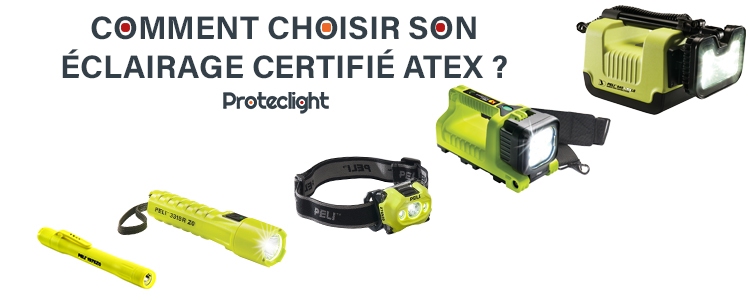
How to choose your ATEX certified lighting? Leave a comment
All about how to choose your ATEX lighting.
It is imperative to have the right ATEX lighting when working in industries or areas containing explosive atmospheres.
But how do you choose your ATEX certified lamp?
In the Proteclight article on ATEX Regulations, we reviewed what ATEX regulations are, the different classes and categories of hazardous areas, and the Peli™ explosion proof products for working in ATEX areas offered by Proteclight.
To quickly recap, the ATEX regulation is a European directive aimed at controlling all hazards related to EXplosive areas and ATmospheres, hence the acronym ATEX. A potentially explosive atmosphere is a mixture of gases, vapors, mists or dusts in the air which combined together and with certain operating conditions, can ignite.
This is why it is important to choose your ATEX equipment according to the type of lighting you need and the environment in which you work.
Where is an ATEX lamp required?
As explained above, explosive atmospheres can be caused by flammable gases, mists, vapors or combustible dusts. Therefore, they can exist just about anywhere. That said, there are a number of industries, sectors and workplaces in which these explosive atmospheres are more likely to exist and, therefore, present a hazard to those who work in these areas.
Explosive atmospheres are present in places such as:
- Fire and rescue services
- Production on chemical sites
- The offshore sector (oil platforms)
- Petrochemical industries
- Oil and gas refineries
- Gas stations
- Underground extraction wells
- Food processing plants
- Grain handling, drying and storage plants
- Automotive manufacturing and repair facilities
- Furniture manufacturing facilities
- Wood and aluminum shops
- Pharmaceutical companies
- Sugar mills/refineries
- Aircraft/aviation inspection sites
- Paint and varnish production sites
- Industrial bakeries
- Repair shops
- Tank inspection sites
- Marine locations
- Power plants
Once you have determined if your industry or workplace requires the use of ATEX certified equipment, the next step is to determine which ATEX Zone your workplace belongs to. To reduce the risk of explosion, the use of properly certified ATEX equipment is imperative.
As explained in the Proteclight article on ATEX Regulations, there are different zones in explosive atmospheres classified according to the potential hazardous risk that each zone presents. Only appropriate certified equipment may be used in each zone.
These hazardous areas are listed in three classes and three categories, each with a zone name:
- Class I: these are areas with the presence of flammable gases, vapors or liquids. The first category of zone concerning these substances means the presence and the certain danger of explosion during an intervention in a dangerous and highly flammable area. This zone is called Zone 0. The second category, also called Zone 1, lists zones with a probable danger linked to an explosive atmosphere. The last category, named Zone 2, is a low hazard zone concerning flammable risks with a low probability of explosive risks.
- Class II: This second class defines areas with combustible dusts such as metals, coal or grain. The category listing areas with a definite danger of flammable dusts is called Category 1 or Zone 20. Category 2 (Zone 21) lists work areas where the hazard is not certain but probable. The last category of this class, named Category 3 or Zone 22, defines areas with a low risk of combustible dust in the air.
- Class III: This last class of zone lists environments with the possible presence of flammable fibers and flying particles.
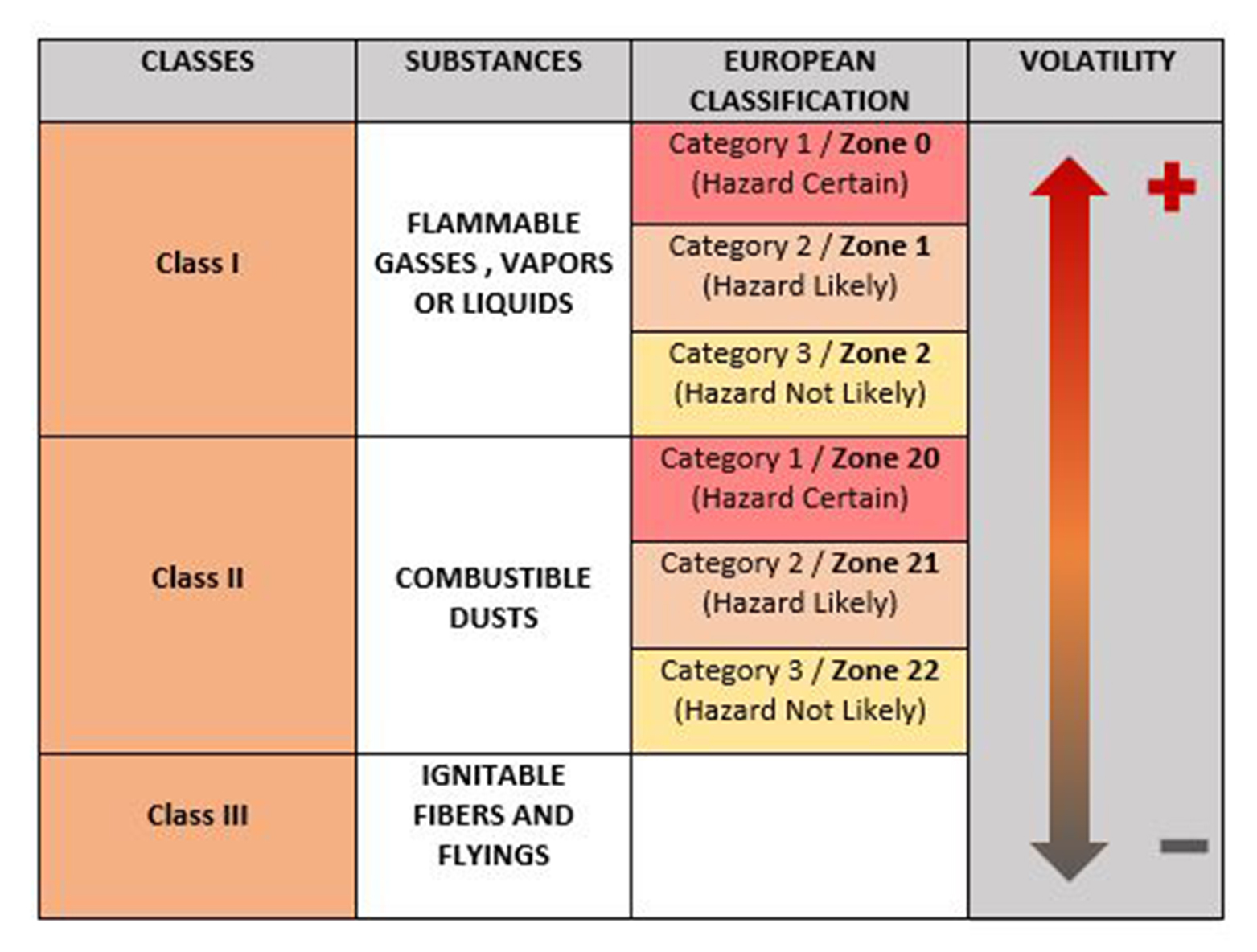
These European classifications, divided into 3 different categories and zones, are defined by their own characteristics.
- The zones associated with category 1 (Zone 0 and Zone 20) are environments with flammable materials for long periods, more than 1000 hours per year on average.
- Zones 1 and 21, associated with category 2 are areas with flammable materials present during normal operation, between 10 and 1000 hours per year.
- Category 3, less risky, represents zones 2 and 22 defined by a rate of flammable materials present for less than 10 hours per year.
This summary table will help you determine which category of equipment is appropriate for you based on the level of risk in your profession.
| CATEGORY 1 | CATEGORY 2 | CATEGORY 3 | |
|---|---|---|---|
| Zone 0/20 | Zone 1/21 | Zone 3/22 | |
| Zone criteria |
(> 1000 h./year) Always safe with two defects. |
Where an atmosphere is likely to occur during normal operation. (Between 10> 1000 h./year) Increased safety in abnormal operating conditions. |
Where an explosive atmosphere is not likely to occur during normal operation and if it does occur, it will exist for only a short period of time. (<10 hrs/year) Appropriate equipment under normal conditions. |
| Risk | Certain | Likely | Unlikely |
| Approved categories | 1G 1D |
1G / 2G |
1G / 2G / 3G 1D / 2D / 3D |
What types of ATEX lighting to choose?
The next consideration is the type of light you need.
A headlamp is a light source attached to the head. This type of light can be attached to a helmet or to a bare head with adjustable straps.
They are commonly used for outdoor activities that take place at night, such as hiking, camping or mountain biking, or for activities in dark conditions, such as caving.
But headlamps can also be used in professional settings, especially for occupations that require hands-free operation such as automotive repair, search and rescue operations, underground mining etc... If your activity takes place in areas with explosive atmospheres and requires hands-free operation, a headlamp may be the right lighting solution for you.
Peli™ 2765 ATEX Zone 0 Headlamp:
.jpg)
This headlamp meets the highest ATEX standard (Zone 0, Cat 1). It features a fabric strap, rubber strap and helmet mounting bracket.The body of the Peli™ 2765Z0 ATEX Zone 0 headlamp is rotatable 45 degrees. In the upright position, each LED illuminates downward. The headlamp weighs only 96 g and provides 4 different lighting modes. Its maximum battery life is 14 hours.
Peli™ 2785Z1 ATEX Zone 1 Headlamp:
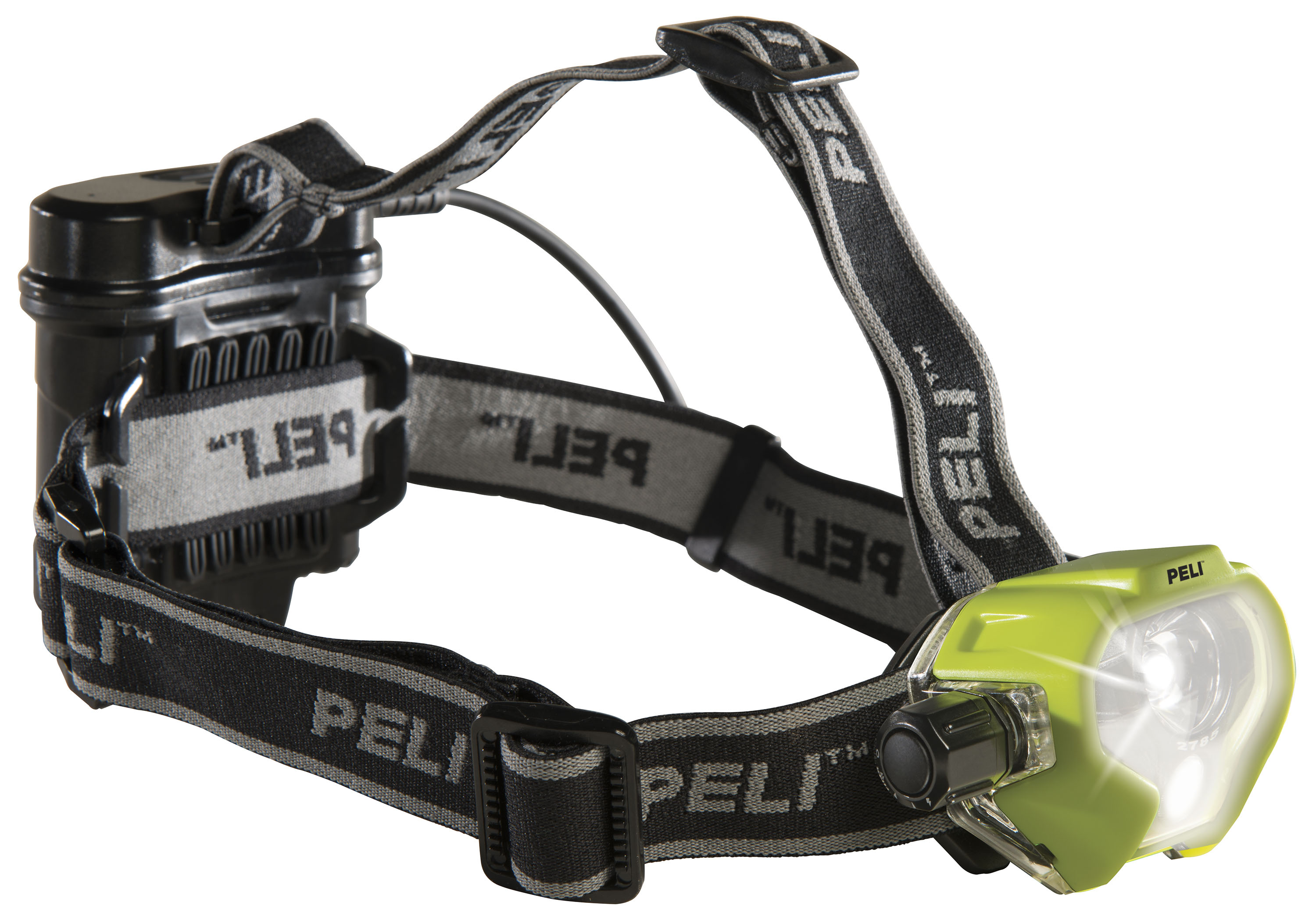
The Peli™ 2785Z1 ATEX Zone 1 Headlamp is ATEX Zone 1 Cat.2 certified for use in environments where the risk of explosion exists on an occasional basis. The Peli™ Zone 1 headlamp has a maximum output of 215 lumens and a 100-hour runtime.
This LED headlamp has two different straps and can be worn on a helmet or directly on the head. It has a 70 degree swivel. The Peli™ 2785Z1 lamp produces two complementary beams of light.
The Peli™ angled flashlight is a great alternative to using a headlamp to keep your hands free. In fact, the Peli™ angled torches are equipped with a clip to attach them securely to a work jacket and thus free the user's head for better working comfort.
Angled lights are widely used in professional settings, including firefighters, military, industrial maintenance and railroad maintenance departments. If you are a member of this profession and you have to be in contact with explosive atmospheres and you want to have your head free for a better working comfort, an angled flashlight will suit your needs.
Peli™ 3415MZ0 Atex Zone 0 Angled Flashlight:
The angled flashlight has a swivel head. Depending on the lighting position, the flashlight provides up to 329 lumens and 15 hours of runtime. It also has dual LED lighting for close-up front vision or distance lighting.
The magnetic clip on the Peli™ 3415MZ0 flashlight allows for hands-free work in the most appropriate position.
Peli™ 3315RZ1-RA Atex Zone 1 Angled Flashlight:
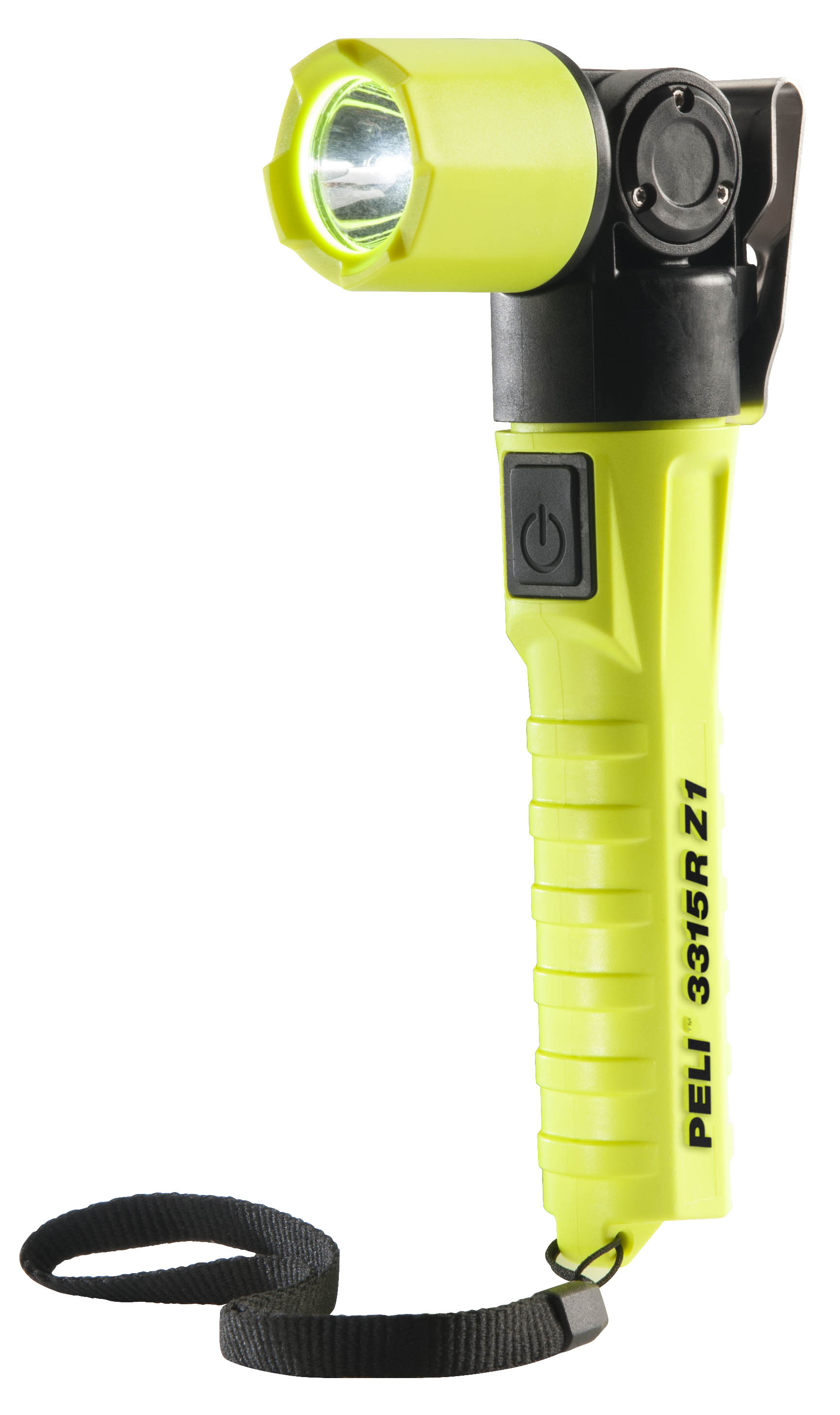
The Peli™ 3315RZ1-RA LED flashlight features a hanging clip so you can work hands-free in complete safety. Its ABS resin body gives it great resistance, ideal for dark and risky intervention areas. Its articulated head allows it to illuminate areas with power and precision.
-
STRAIGHT TORCHES
Straight flashlights could be considered more versatile than a headlamp or an angled flashlight, as they offer the possibility to be used as a traditional hand-held flashlight, to be attached to a helmet or work clothes for hands-free use, or to add an articulated head to adjust the angle and positioning of the light beam. They are therefore multi-purpose lamps.
The ATEX certified straight torches will be perfect for all professionals working in an industry with high explosion risks such as chemical, pharmaceutical, electrical, oil, gas or firefighting industries.
Peli™ 3315Z0 ATEX Zone 0 Flashlight:
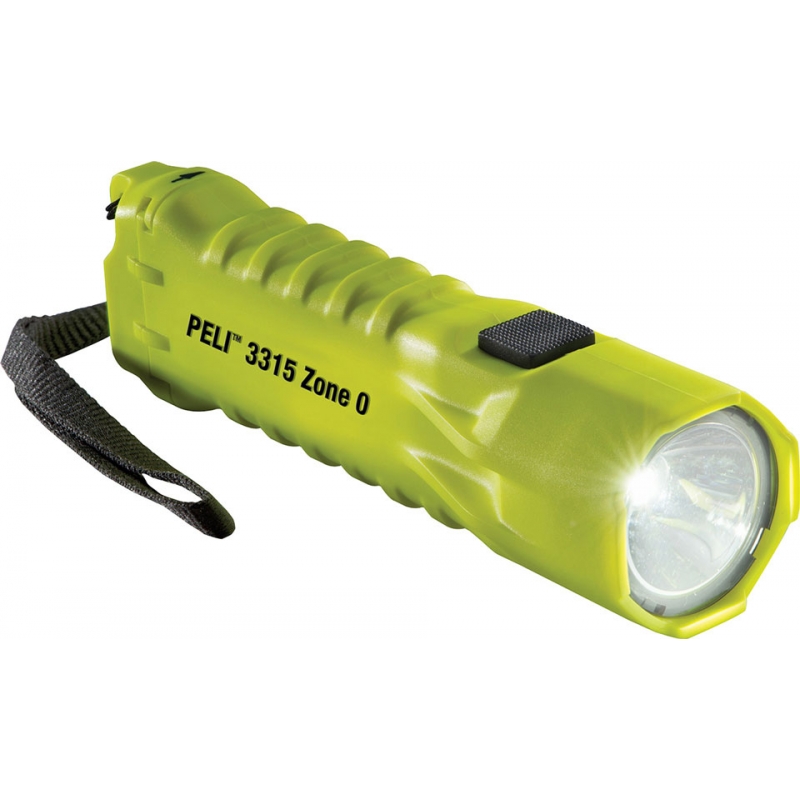
The Peli™ 3315Z0 ATEX Zone 0 flashlight consists of an unbreakable ABS body ensuring easy handling. The battery compartment is lockable. A single LED behind a shockproof lens glass provides the illumination light. With 3 LR06 batteries, the ATEX Zone 0 flashlight has a battery life of 19 hours. The ATEX Zone 0 flashlight is certified static free. ATEX zone 0 lamps allow you to work in explosive areas without risk.
Peli™ 3315RZ1 Atex Zone 1 Flashlight:
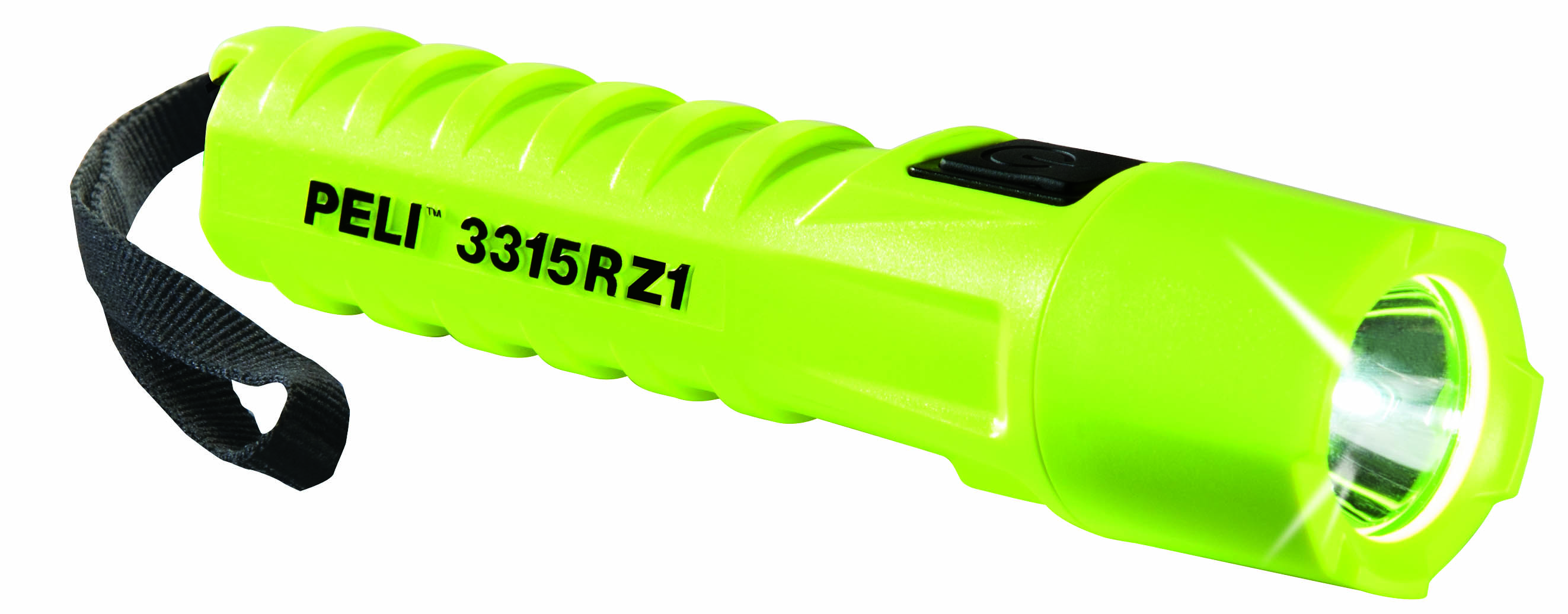
Small and lightweight, the ATEX Zone 1 Peli™ flashlight is an essential accessory for dark, hazardous areas. Its ABS resin body makes it ultra impact resistant.
The Peli™ 3315RZ1 flashlight can be supplemented with a right angle adapter with a hanging clip for hands-free use.
Worklights, also known as Remote Area Lighting Systems (RALS), are designed to illuminate larger work areas such as emergency scenes, underground mines, or rail and road work sites. These lights are fully portable, powerful, energy efficient and rechargeable, so they can be used to light remote areas, confined spaces and large work areas just about anywhere. Peli™ offers a RALS model, the 9455Z0, which is ATEX Zone 0 (Category 1) certified, the only RALS fixture on the market that allows for lighting in ATEX zones. If you need a large, ATEX-certified area light to illuminate an explosive atmosphere area, the RALS 9455 floodlight is for you.
The Peli™ 9455 RALS Atex Zone 0 Floodlight:
.jpg)
The Peli™ 9455 RALS Atex Zone 0 floodlight is an LED area lighting floodlight. Featuring a 1600 lumen beam, it combines lighting power, protection and range. This headlamp is an indispensable reference for firefighters and intervention services.
With a low weight, the portable device is equipped with a mast for an export of the beam. The work in the intervention zone is done in complete safety. Its rechargeable battery features give the Peli™ ATEX headlamp an ideal autonomy of up to 10 hours.
What features does your ATEX light have?
When choosing your ATEX lighting, the features of your lamp are also elements to consider based on your needs.
-
RECHARGEABLE
If you need continuous lighting, rechargeable lamps will not only be more economical since you will not need to buy batteries on a regular basis, but they will also provide you with a better autonomy (5h autonomy for the least powerful, 20h autonomy for the most powerful).
Peli™ 3765Z0 Atex Zone 0 Rechargeable Angled Flashlight:
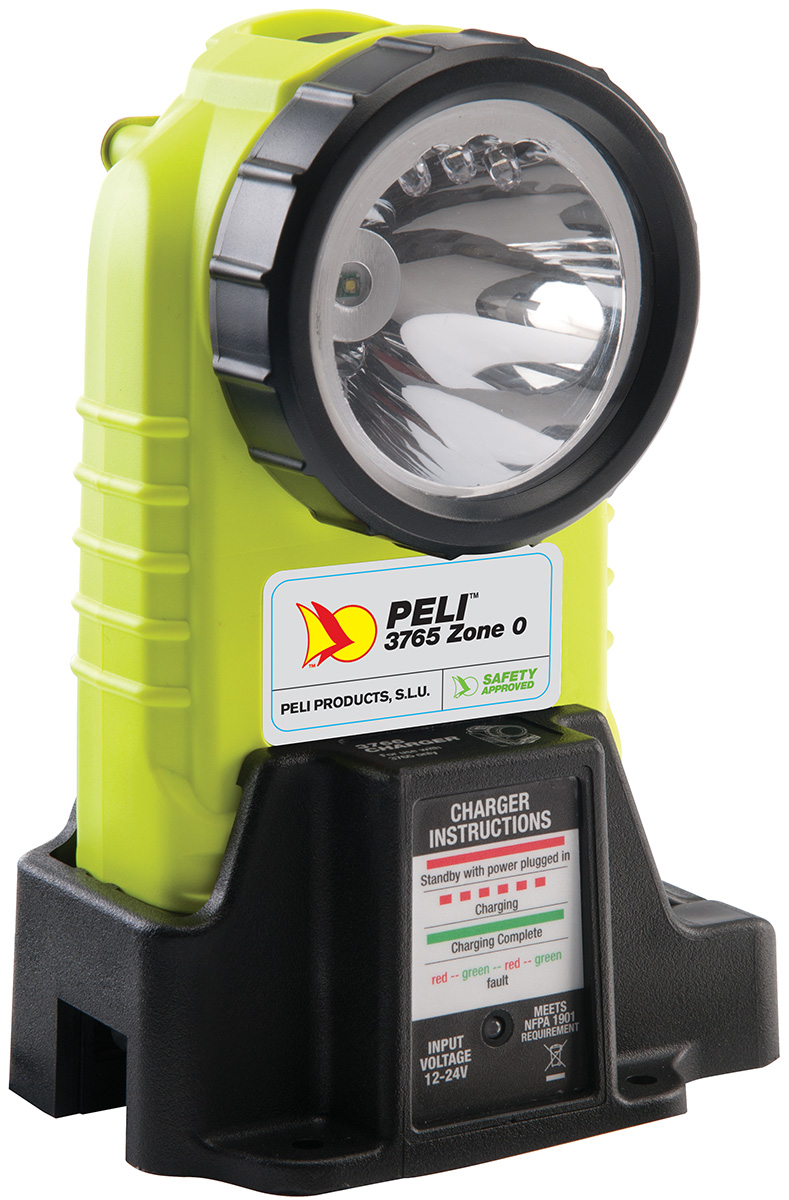
The Peli™ 3765Z0 rechargeable ATEX Zone 0 angled flashlight has 4 lighting modes, including downward. It can be used in hazardous areas, like all Peli™ ATEX Zone 0 flashlights. The ATEX 3765Z0 LED flashlight has a light output of 194 lumens and a lighting distance of 256 meters. It is rechargeable with its 4 NiMH batteries that provide up to 20 hours of runtime.
-
WITH BATTERIES
If you're looking for a compact, space-saving light, look to a battery-powered ATEX light.
Peli™ 1975Z0 ATEX Zone 0 Flashlight:
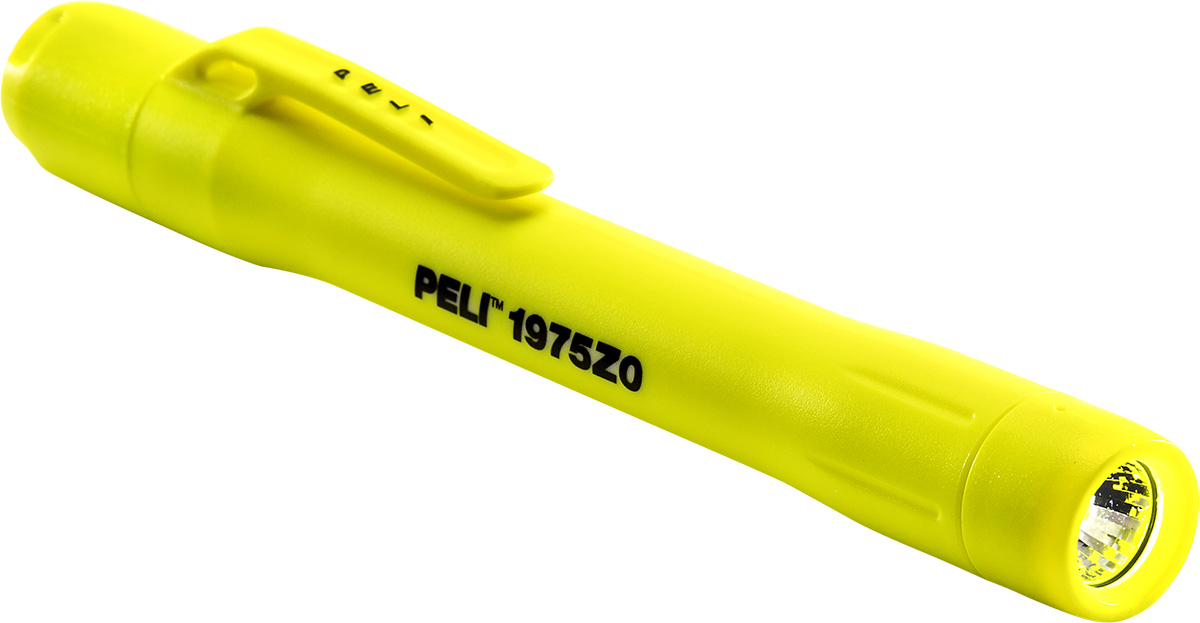
The size of a pen, the Peli™ 1975Z0 ATEX Zone 0 flashlight has the best size to light output ratio of any ATEX Zone 0 flashlight and runs on 2 LR03 batteries. The body of the Peli™ 1975Z0 LED flashlight is guaranteed anti-static and shockproof. It can also be attached to a helmet mount for hands-free use.
-
MULTIPLE LIGHTING MODES
Some ATEX flashlights offer different lighting modes depending on your needs: proximity lighting, distance lighting, bright lighting, dim lighting, flashing lighting... If your lighting will need to change regularly, a flashlight with multiple lighting modes will best suit your needs.
Peli™ 3415MZ0 Atex Zone 0 Angled Flashlight:
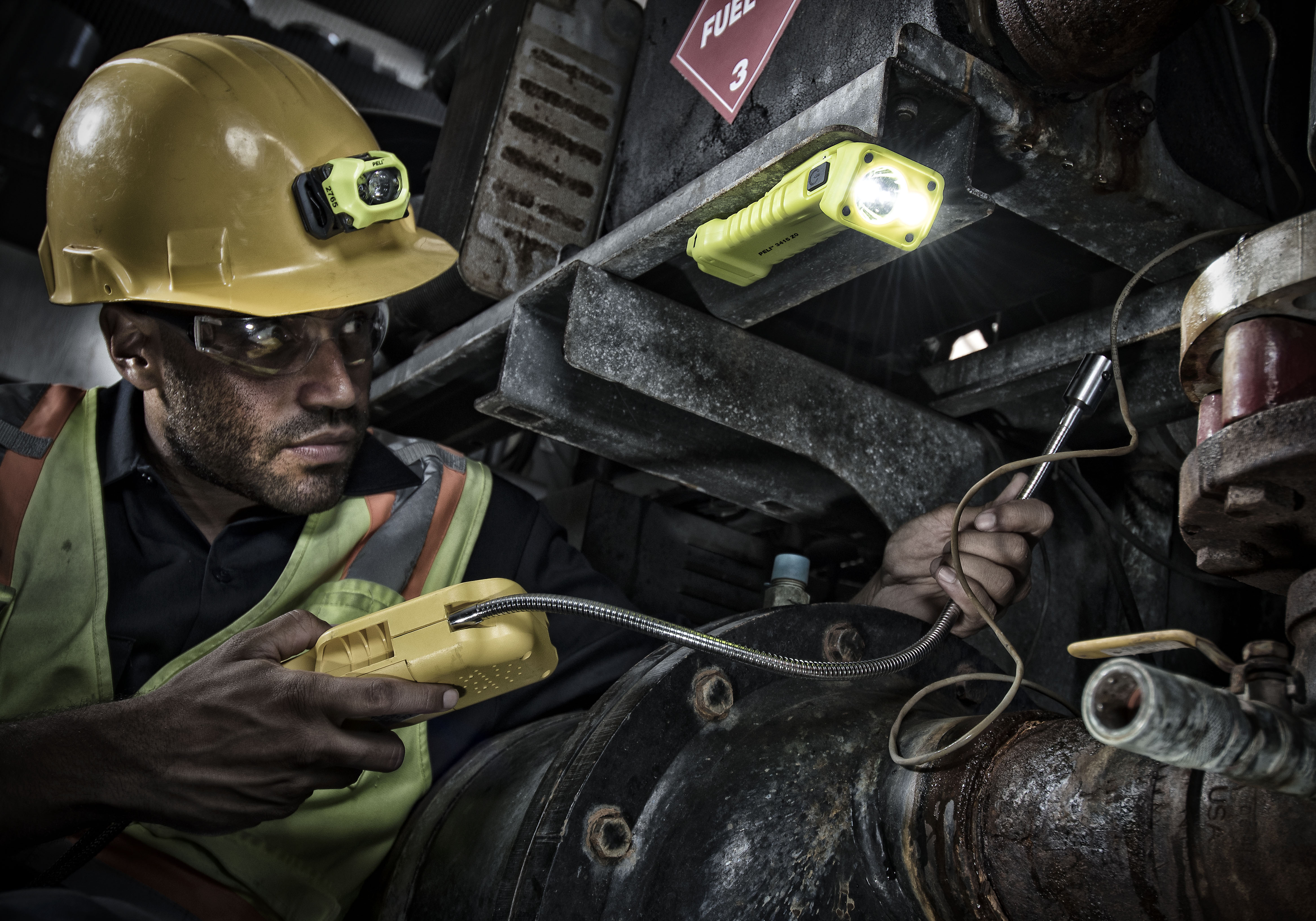
The Peli™ 3415MZ0 Atex Zone 0 Angled Flashlight has a swivel head to adjust the lighting position. Its lighting technology consists of a beam and a spotlight that can be used independently or simultaneously. The side knob allows selection of the light mode of the lighting unit: spotlight, beam, spotlight + beam or flashing.
-
MAGNETIC CLIP
Flashlights with a magnetic clip can be magnetized to a metal surface to illuminate a surface at an angle or to work hands-free.
Peli™ 3415MZ0 Atex Zone 0 Angled Flashlight:
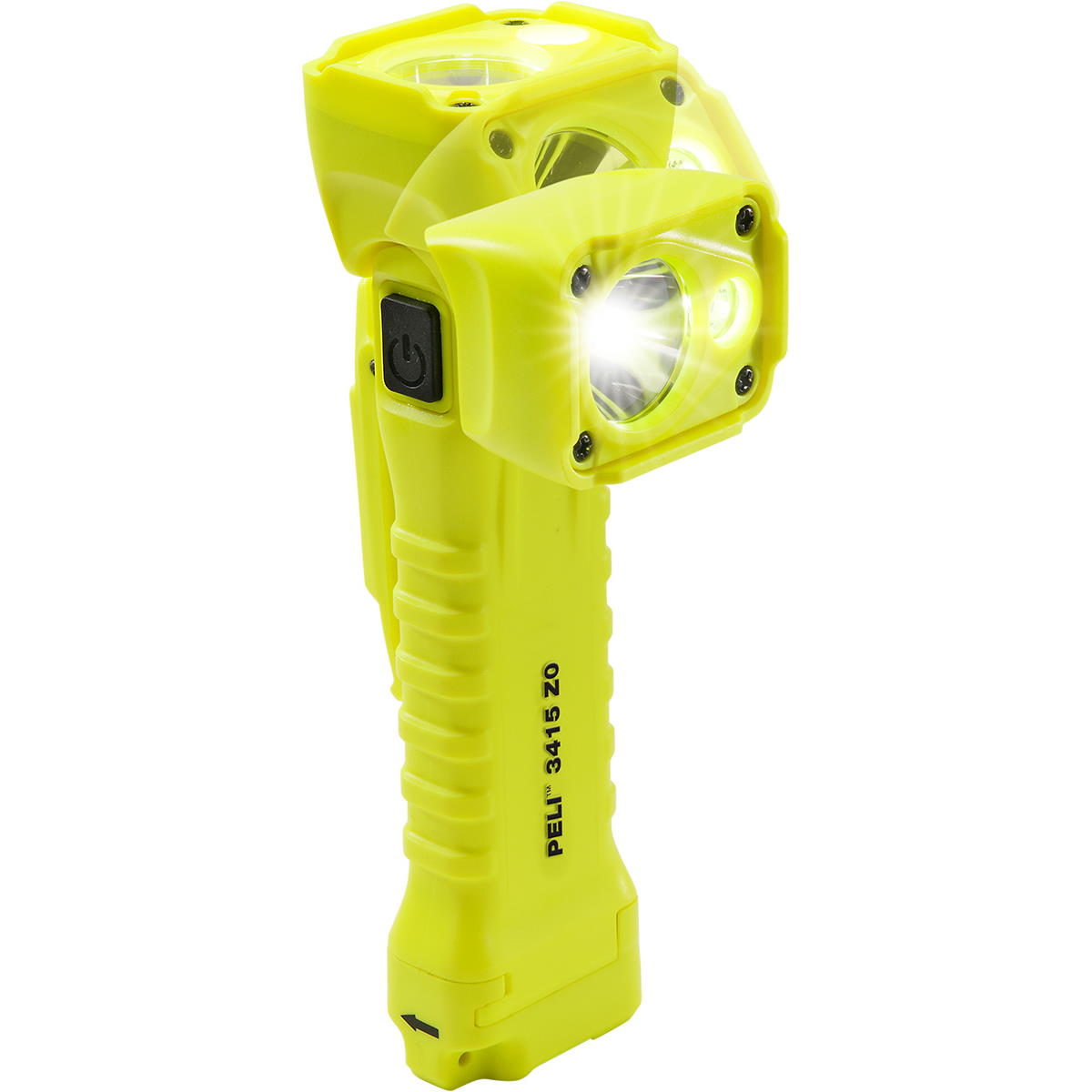
The 3415MZ0 angled flashlight is designed for extreme situations: ATEX certified and waterproof (IPX8 protection rating), it contains an LED light capable of replacing a headlamp. It is magnetic and can be fixed on any metal wall.
-
PROTECTION INDEX
The IP standard, which stands for Protection Index, is used to calculate the watertightness and protection against solid bodies of products. There are several degrees of protection (see Proteclight article on The certification of Protection Indices).
Among the ATEX Peli™ lamps sold on Proteclight, the ATEX Peli™ 3315 lamps (3315Z0, 3315RZ0, 3315RZ0-RA, 3315RZ1, 3315RZ1-RA) are the ones with the best Protection Index, since they have an IP67, which means that they are totally protected against solid bodies and dust, and are totally protected against the effects of immersion up to a depth of 1 meter for a duration of 30 minutes.
Peli™ is the only manufacturer to offer such a comprehensive range of ATEX lighting for use in Zone 1 and Zone 0 explosive atmospheres, and there is an ATEX Peli™ lamp for everyone at Proteclight.
Video: Peli™ explosion proof lighting for Atex zones
All trademarks are registered and/or unregistered trademarks of Peli Products, S.L.U., its parent, subsidiaries and/or affiliates.
![]()

Share your opinion!